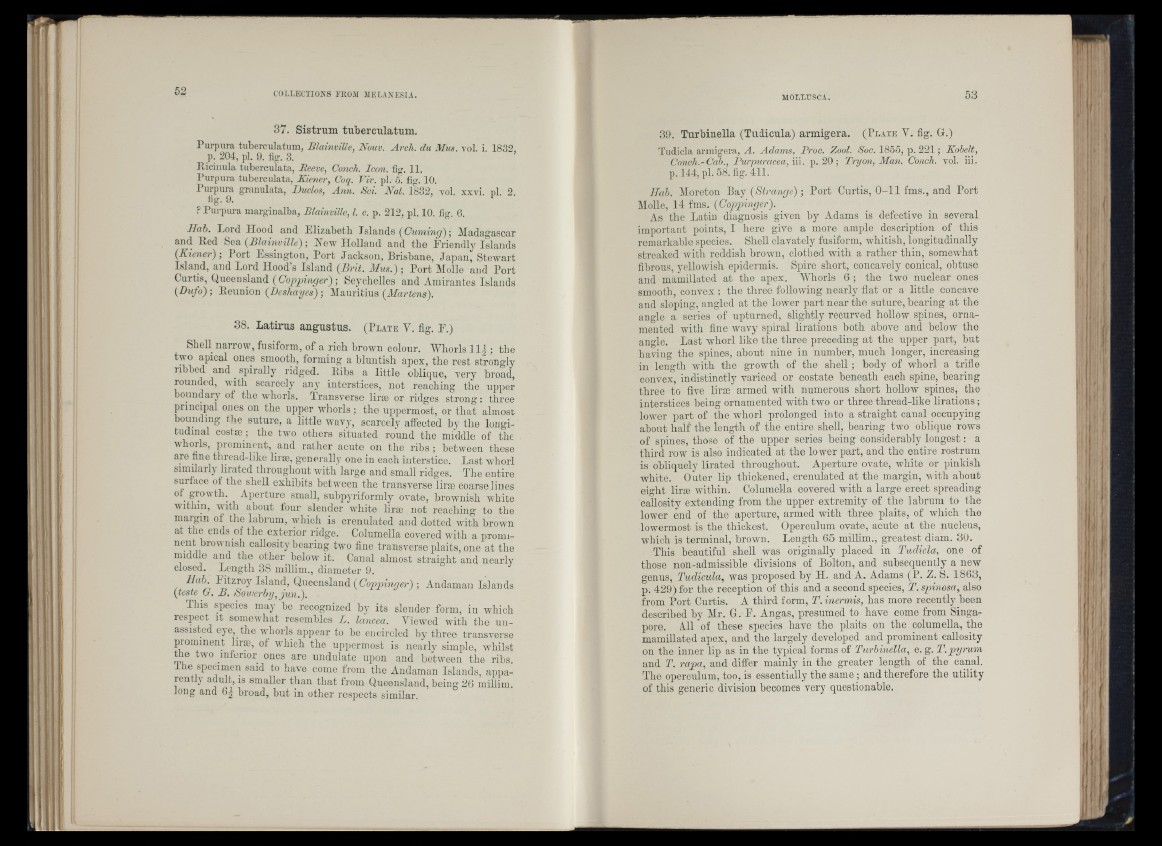
37. Sistrum tuberculatum,
ru rp u ra tuberculatum, Blainville, Kouv. Arch, du Mus. vol. i. 1832
p. 204, pi. 9. fig. 3.
Eicimila tuberculata. Reeve, Conch. Icon. fig. 11.
ru rp u ra tuberculata, Kiener, Coq. Viv. pi. 5. fig. 10.
I ’urpura gTauulata, Duclos, Ann. Sci. Kai. 1832, vol. xxvi. pi. 2.
fig. 9.
? Purpura margiualba, Blainville, I. c. p. 212, pi. 10. fig. 0.
Hah. Lord Hood and Elizabeth Islands ; Madagascar
and lied (Blainville) ■, New Holland and the Eriendly Islands
(Kiener); Port Essington, Port Jackson, Brisbane, Japan, Stewart
Island, and Lord Hood’s Island (Brit. AIus.); Port Molle and Port
Curtis, Queensland (Coppinger); Seychelles and Amirantcs Islands
(Dufo) ; lleuuion (Deshayes) ; Mauritius (Martens).
' Î
38. Latirus angustus. (P late V. fig. E.)
Shell narrow, fusiform, of a rich brown colour. AVhorls 11 | ; the
two apical ones smooth, forming a bluutish apex, the rest strongly
ribbed and ^ spirally ridged, llibs a little oblique, very broad,
rounded, with scarcely any interstices, not reaching the upper
boundary of the whorls. ïransAærse liræ or ridges strong : three
principal ones on the upper whorls ; the uppermost, or th at almost
bounding the suture, a little wavy, scarcely affected by the lougi-
tudmal costæ ; the two others situated round the middle of the
whorls, prominent, and rather acute on the ribs ; between these
are hne thread-like liræ, generally one in each interstice. Last whorl
similarly lirated througlmut Avith large and small ridges. The eutire
siiitace of the shell exhibits between the transverse liræ coarse iiiies
of_ growth. Aperture small, subpyriformly ovate, brownish white
within, with about four slender Avhite liræ not reaching to the
margin of tlie labrum, which is crenulated and dotted with brown
at the ends of the exterior ridge. Columella covered with a promi-
nent broAvmsh callosity bearing two fine transverse plaits, one at the
middle and the other^ below it. Canal almost straight and nearly
closed. Length 38 millim., diameter 9.
Muh Iitz ro y Island, Queensland ( C'o273myer) ; Andaman Islands
(teste 6r. B. Sowerby, jun.).
This species may be recognized by its slender form, in which
respect it somewhat resembles L. lancea. Ahewed with the u n assisted
oye,_the whorls appear to be encircled by three transverse
prominent liræ, of Avhich the uppermost is nearly simple, whilst
the two inferior ones are undulate upon and between the ribs
Ib e specimen said to have come from the Andaman Islands, appa-
reiitlA adult, is smaller than that from Queensland, being 26 millim.
Joug and 6| broad, but in other respects similar.
39. Turhinella (Tudicnla) armigera. (P late V. fig. G.)
Tudicla armigera, A. Adams, Rroc. Zool. Soc. 1855, p. 221 ; Kohelt,
Conch.-Cah., Purpuracea, m . p. 20; Tryon, Man. Conch, vol. iii.
p. 144, pi. 58. fig. 411.
Hcd). Aloreton Bay (Strange); Port Curtis, 0-11 fms., and Port
Molle, 14 fms. (Coppinger).
As the Latin diagnosis given by Adams is defective in several
important points, I here give a more ample description of this
remarkable species. ShcU clavately fusiform, whitish, longitudinally
streaked Avith reddish brown, clothed with a rather thin, somewhat
fibrous, yellowish epidermis. Spiro short, concavely conical, obtuse
and mamillatcd a t the apex. AAtoorls 6 ; the I avo nuclear ones
smooth, convex ; the three following nearly flat or a little concave
and sloping, angled at the loAver part near the suture, bearing at the
angle a series of upturned, slightly recurved hollow spines, orna-
meuted with fine Avavy spiral lirations both above and below tho
angle. Last whorl like the three preceding at the upper part, hut
having the spines, about nine in number, much longer, increasing
in length with the growth of the sh e ll; body of whorl a trifle
convex, indistinctly variced or costate beneath each spine, bearing
three to five lirae armed with numerous short holloAv spines, tho
interstices being ornamented with two or three thread-like lirations;
lower part of the whorl prolonged into a straight caual occupying
about half the length of the entire shell, bearing two oblique rows
of spines, those of the upper series being considerably longest: a
third row is also indicated at the lower part, and the entire rostrum
is obliquely lirated throughout. Aperture ovate, white or pinkish
white. Outer lip thickened, crenulated at the margin, a\ ith about
eight lirae Avithin. Columella covered with a large erect spreading
callosity extending from the upper extremity of the labrnm to the
lower end of the aperture, armed with three plaits, of which the
loAvermost is the thickest. Operculum ovate, acute at the nucleus,
which is terminal, broAvn. Length 65 millim., greatest diam. 30.
This beautiful shell was originally placed in Tudicla, one of
those non-admissible divisions of Bolton, and subsequently a new
genus, Tudicula, was proposed by H. and A. Adams (P. Z. 8. 1863,
p. 429) for the reception of this and a second species, T. spinosa, also
from Port Curtis. A third form, T. inermis, has more recently been
described by Mr. G. E. Angas, presumed to have come from Singapore.
A.11 of these species have the plaits on the columella, the
mamillated apex, and the largely developed and prominent callosity
on the inner lip as in the typical forms of Turhinella, e. g. T.pyrum
and T. rapa, and differ mainly in the greater length of the canal.
The operculum, too, is essentially the same ; and therefore the utility
of this generic division becomes very questionable.
I